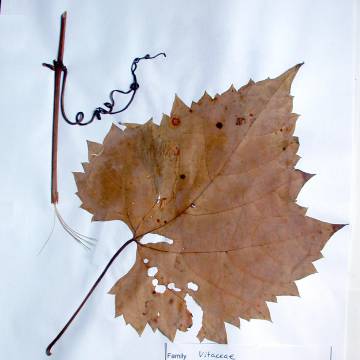

Vitis riparia - (image 1 of 6)
Taxonomy
Family: Vitaceae
Habitat
Common in moist woods and thickets. Also in sandy woods, on sloping dunes, in fallow fields, and along fencerows.
Associates
Distribution
New Brunswick and Quebec west to MT, south to VA, TN, AR, and TX.
Morphology
Deciduous vine. Stems high-climbing, the pith interrupted by a diaphragm 0.5-1 mm thick at each node (2 mm at maturity); branches of the current season green to gray or brown; tendrils or panicles produced opposite most leaves, commonly lacking each third leaf. Leaves rotund, 10-20 cm, usually with 3 forward pointing lobes, coarsely and sharply serrate, the teeth often longer than wide with one or both sides concave, pubescent beneath when young, remaining pubescent in the vein-axils and sometimes along the veins. Panicles 5-10 cm. Fruit black, glaucous, 6-12 mm.
Notes
Flowers early May to late June
Wetland indicator: Facultative Wetland -
When used as a wine grape, the flavor is often described as "foxy".
References
Gleason, Henry A. and A. Cronquist. 1991. Manual of Vascular Plants of Northeastern United States and Adjacent Canada. Second Ed.
The New York Botanical Garden. Bronx, NY
Swink, F. and G. Wilhelm. 1994. Plants of the Chicago Region.
Indiana Academy of Science. The Morton Arboretum. Lisle, Illinois.
|
Michael Hough © 2005 |